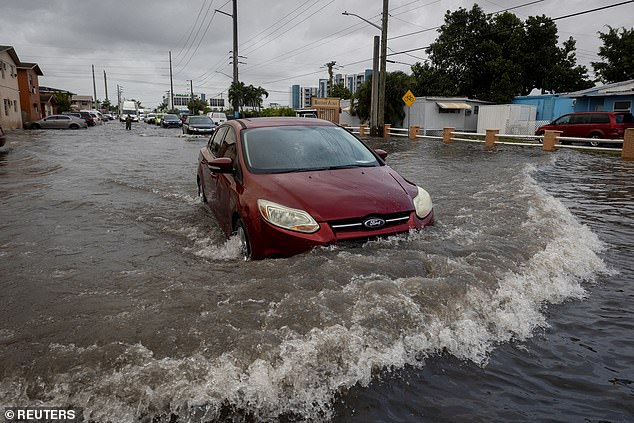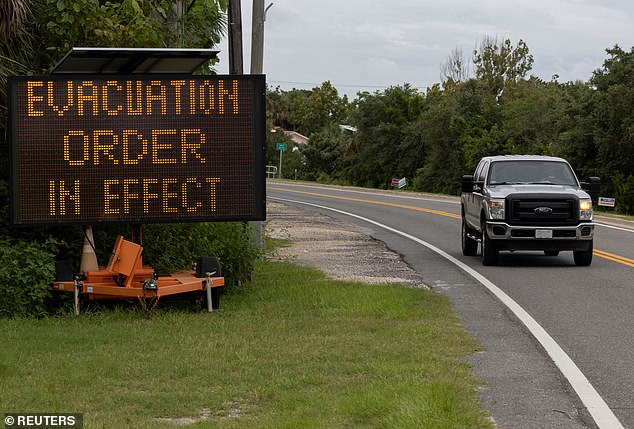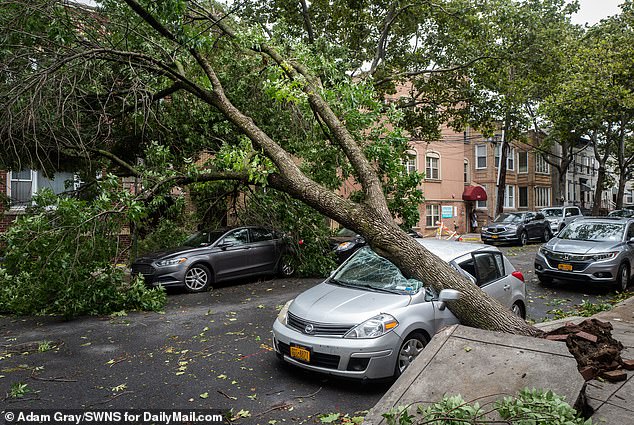I’m a meteorologist – here’s why Storm Helene is causing ‘tremendous’ concern among experts
Of all the storms to hit the US in recent years, Hurricane Helene is of “enormous” concern to experts.
The storm was upgraded to a Category 1 hurricane at the last minute today, meaning authorities are scrambling to implement safety measures and issue evacuation orders.
Residents received only a little over a day’s notice of the hurricane, but the National Hurricane Center (NHC) typically issues 36 hours of warning, giving people ample time to prepare for the storm.
“The damage will be enormous,” University of Georgia professor Pam Knox told DailyMail.com.
The hurricane is expected to hit the west coast of Florida between 6:00 p.m. and 10:00 p.m. ET on Thursday, packing winds of up to 125 mph (200 kph).
That’s nearly twice the winds of Hurricane Debby, which struck last month and caused an estimated $28 billion in damage and economic losses.
Hurricane Helene will move inland all the way to Atlanta and then up the East Coast into North and South Carolina. These areas have not been hit by a major hurricane in almost 30 years.
Tropical Storm Helene was upgraded to a hurricane on Wednesday, the day before it is expected to make landfall in Florida
“The storm is rapidly intensifying and moving quickly, causing high winds around the storm to impact a larger area than normal,” Knox said.
‘It is also a very large storm, which means that the consequences reach further from the center than with more compact storms.
“The impacts will be felt in many places, such as Atlanta, where such extreme wind and rain do not often occur. Many people are therefore not prepared for it.”
A Category 4 or higher hurricane is certainly a possibility this week, meaning areas like Tallahassee, Florida could look very different Friday morning.
There are already about 32 million people under flood warnings, from South Florida to South Virginia.
The force of the tropical winds is expected to reach a width of more than 400 miles (640 kilometers), twice as wide as Hurricane Debby and Hurricane Idalia, which struck in August of last year.
Hurricane Idalia killed 12 people, while Debby claimed 10 lives.
Meteorologists are concerned that people in affected areas such as Atlanta and the Carolinas are unprepared for the storm, as a Category 3 or higher hurricane hasn’t hit the area in decades.
The areas of greatest concern are Florida and Georgia, although states like Alabama and Tennessee, which are not used to these types of storms, will also see strong wind gusts. floods and currents power outage caused by fallen trees and power lines.
The severity of the hurricane can cause areas that are normally dry to experience flooding they have never experienced before. An example of this is the Ochlocknee River in southwest Georgia, where water levels can reach 10 to 15 feet.
Heavy rainfall can overload drainage and pumping systems, leaving water with nowhere to go, leaving people stranded for days or weeks until rescuers arrive.
“If you live on the coast, particularly the Florida coast from Apalachicola to Tampa, the storm surge is going to be very high and a lot of people are going to be evacuated before the water level can rise 12 feet or more,” Knox said.

Hurricane Helene is expected to cause flooding up to 15 feet (4.5 meters) in some areas
The hurricane is strengthening as it passes Mexico and heads toward the Gulf Coast, reaching winds of 80 mph (130 kph).
Meteorologists warn that the hurricane, fueled by record temperatures in the Gulf of Mexico, could reach wind speeds of up to 200 kilometers (125 mph) by the time it makes landfall.
“Helene is just now entering the Gulf of Mexico,” Knox said, “so there’s really nothing stopping her from getting stronger.”
Although hurricanes typically weaken after making landfall, meteorologists warn that Helene could remain a hurricane for 12 hours or more.
Experts have not yet commented on the exact extent of the devastation that Hurricane Helene could cause, but the National Hurricane Center (NHC) has confirmed that the hurricane could be “life-threatening.”
There are two factors that cause the hurricane to become stronger. One is the change in wind speed or direction, also known as wind shear. This decreases as the storm approaches the US.
Wind shear causes the top of a developing tropical cyclone to be blown off, much like a hat being blown off your head. This prevents the cyclone from developing into a stronger storm.
However, if wind shear disappears or decreases (as with Hurricane Helene), the storm can grow vertically, strengthening its circulation and increasing its reach.

Parts of Florida are already under evacuation orders as the storm could reach Category 4
The second factor is the “record high temperatures in the eastern Gulf of Mexico,” which the storm is expected to pass directly over.
“The warm water acts as fuel for the storm, causing it to rapidly intensify. We call this ‘rapid intensification’ because the storm’s pressure can drop rapidly, and the wind speed around the storm’s center will increase,” Knox said.
The NHC is now urging people to prepare for the approaching storm, with several counties in Florida already under evacuation orders.
According to the NHC, Hurricane Helene will impact most of Florida’s west coast within a 36-hour period. Residents should expect heavy winds and rainfall, which could knock down trees and power lines, causing power outages that could last for days.
Florida Storm Chasers said in a after on X that the most recent Global High-Resolution Atmospheric Forecasting (GRAF) model “still suggests Helene could explode to a Category 4 before making landfall anywhere in the Big Bend of Florida.”

Meteorologists warned that the hurricane is likely to knock down trees and power lines, causing widespread power outages along the west coast of Florida and Georgia.
Knox advised people to invest in generators or batteries to provide temporary power while they wait for companies to come and repair the broken cables.
People should prepare by making sure their gas tanks are full, their cell phones are charged, and that they have enough water and nonperishable food to last at least a week after the storm.
“Any loose objects in gardens, such as chairs, tables and ornaments, should be brought inside so they cannot be fired into the air as projectiles,” Knox said.
Josh Morgerman, a self-proclaimed hurricane hunter, placed about the ‘ominous signals this morning’ coming from Helene and warned that ‘a dangerous situation was developing.’
He warned Florida residents not to make assumptions about Helene based on past experiences with Debby and Idalia, stating that “this situation is likely to be much more serious” and cautioned people to “take it seriously.”
